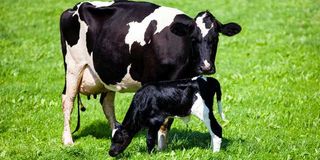Hey, cows usually need no assistance during calving

Calving of cattle should be left to occur naturally as much as possible. When farm animals frequently get birth difficulties, it is an indication of poor livestock nutrition and management.
The question of whether to intervene or not when the animal is calving has come severally to me and I have answered it without tiring. The latest came two weeks ago. Usually, farmers who call are on site with a cow that is calving. The majority say the cow is struggling too much and they feel it is their responsibility to assist.
Before I proceed, let us ponder this: Who assists the buffaloes and wild cattle; yet their population keeps increasing unabated?
The answer lies in a cardinal rule of nature that applies to all species; “all animals are created to propagate themselves without the help of others”.
However, since man discovered medicine and surgery and also domesticated some animals for his socio-economic gain, it is inevitable that sometimes he will assist domestic animals in giving birth.
Granted that natural birthing is usually uneventful, there are situations that make it difficult to occur smoothly and successfully. In some cases, even both the foetus and the mother may die in the process.
In the natural environment, the number of animals dying when giving birth is very small. Even in the farm situation, calving of cattle should be left to occur naturally as much as possible. When farm animals frequently get birth difficulties, it is an indication of poor livestock nutrition and management.
Human interference
One of the most common causes of difficult calving in cattle is ignorant human interference that derails the self-controlling sequence of events during delivery.
It is important for farmers to understand that cows have a birthing programme that they follow. The process kicks off a few weeks before the actual delivery.
I will explain about cows because that is the most kept livestock locally. It should nonetheless be noted that all mammals go through a similar process of birthing.
Scientifically, birthing is called parturition. It comprises three distinct stages with timing with a wide range of timelines because of the myriads of circumstances of individual animals. The stages are dilation of the cervix, delivery of the calf and delivery of the placenta or afterbirth.
Farmers tend to miss the first stage because it is very gentle and takes a number of the last days of pregnancy to complete. The stage starts with mild unnoticeable contractions of the uterus. The cervix softens and ligaments of the hip area relax. The relaxation makes the muscles of the hip flabby and the udder appears to have gone closer to the ground.
There is a heavy enlargement of the vulva and thick clear mucus called a “string” may hang out of the vulva. The cow’s appetite reduces and the animal prefers to stay away from others.
Stronger but still invisible uterine muscle contractions begin at the end of this stage. They push the contents of the uterus close to the opening of the cervix. The contractions also align the calf to the birth canal opening in readiness for delivery. The pressure of the membranes of the foetus, foetal fluids and the foetus causes further opening of the cervix, signalling the start of stage two.
Labour
The foetal membranes that hold fluids and the calf are called the water bag. In stage two, they pass through the cervix pushed by heavily noticeable uterine contractions. That is when the cow starts heavy pushing and is said to be in labour. At this point, most farmers will know their cow is giving birth.
Once the water bag appears at the opening of the vulva, calving should be completed within 20 minutes to five hours depending on the health of the cow and how experienced she is in birthing. Healthy cows that have calved before may take 20 minutes while healthy heifers may go up to two hours.
At stage two, when the water bag shows up, some farmers call me and ask if they should puncture it. Others will wait for it to puncture naturally and ask if they should then pull out the calf. Once the cow has popped out of the water bag, just stay out of sight of the animal and watch quietly. This is because the process is continuing, according to its natural plan.
Stage two progresses with the cow presenting the calf in two normal positions. The first is the most common. The water bag bursts and reveals the two front legs of the calf with the hooves facing down if the cow is standing. If the cow is lying down, the hooves will face the hooves of the mother. The head will come out, nose in between the front legs of the calf and facing backwards of the cow. The neck is straight but faces down as the calf makes the final exit from the uterus. This is called the normal anterior presentation of the calf.
The normal posterior presentation occurs with the hind legs first and calf hooves facing up. The tail is in between the hind legs. Farmers should note that any other presentation of the calf is abnormal and the calving cannot complete without assistance. The best option is to report to their animal health service providers for help.
The final stage of delivery is the dropping of the afterbirth. In cattle, it occurs within 8 to 12 hours after calving.
Beyond that, it is an abnormality called retained afterbirth (RAB). It should be reported to the farmer’s animal health service provider for assistance.





